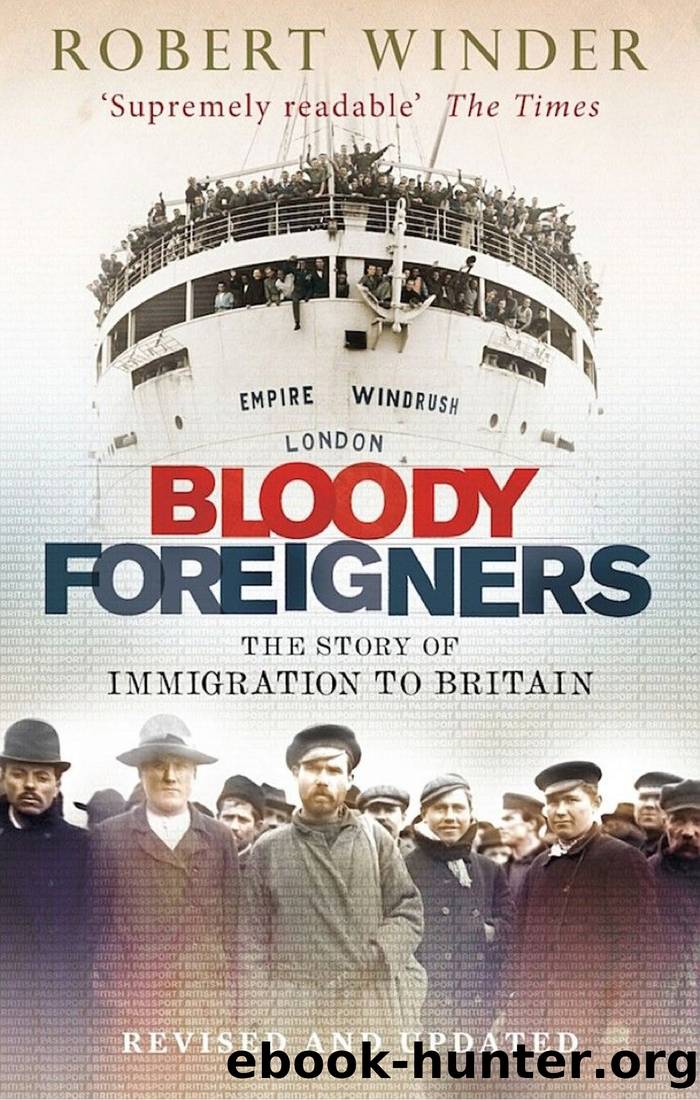Bloody Foreigners: The Story of Immigration to Britain by Robert Winder

Author:Robert Winder [Winder, Robert]
Language: eng
Format: epub
Tags: Autobiography, Biography, Emigration & Immigration, History, Social Science
ISBN: 9780748123964
Google: 7ORcaQIgdcEC
Amazon: B0048BQR9K
Publisher: Abacus
Published: 2010-11-04T00:00:00+00:00
CHAPTER 19
Imperial Friends and Foes
In the late summer of 1939 a pretty young Dutch-Irish girl called Eda van Heemstra was hastily evacuated from a boarding school in Kent by her mother, who feared that south-east England would soon be struck by a thunderous aerial bombardment. She was by no means the only child to be steered away from the flightpath of the anticipated German bombing campaign. Indeed, she was one of the few able to take refuge by the simple expedient of going home. Home, however, was Holland – Arnhem, of all places – and it would prove to be even more pregnant with peril than the place she had fled. A few years later, in one of the final paroxysms of the war, Arnhem would be pounded into rubble. The girl survived, and in 1948 she was able to return to England to pursue her theatrical career. Like many gorgeous young actresses, she gave herself a marketable stage name: Audrey Hepburn. She would soon become the radiant epitome of English beauty.
In many ways the Second World War was a reprise or continuation of the First, but this time it was a war of rapid movements, sudden retreats, vast distances and pulverising power. It was also the first clash in which civilian populations were as vulnerable as armies. The conflict rolled across Europe and the world like a hurricane, juddering borders, engulfing and dispersing entire peoples as it went.
Once again Britain summoned its colonial subjects to arms, and once again they came. Political protest had done little to dislodge the famous colour bar but the exigencies of war toppled it in a flash. In October 1939, the Colonial Office announced in both Houses of Parliament that all British subjects from the colonies, of whatever race or colour, were ‘on the same footing as British subjects of pure European descent’. In practice, only the RAF took this ruling to heart: ten thousand West Indians entered its hangars and cockpits. The army and the navy both continued to rule out coloured officers.* The Indian army, meanwhile, tossed an unprecedented three million men into battle. Lascars, Africans and Orientals sweated below decks on the great Imperial Fleet, or were sucked into gaps in the mines, munitions factories and forests of Britain itself. Round and round the world they went, from Orkney to Trincomalee, in a demographic upheaval which would have resonant consequences. When the guns fell silent, it was at first hoped that life could return to normal, that things could once more be as they had been before 1939. But the technology that had made the conflict so far-flung and destructive – air power – had altered the world’s horizons for good. The propaganda deployed to bolster and refuel Britain’s fighting spirit, meanwhile, emphasised our insular bloody-mindedness – we were an unassailable fortress; we would fight on the seas and oceans – at precisely the time when it was no longer even close to the truth. The battleship was obsolete; the sea was no longer a moat.
Download
This site does not store any files on its server. We only index and link to content provided by other sites. Please contact the content providers to delete copyright contents if any and email us, we'll remove relevant links or contents immediately.
Cecilia; Or, Memoirs of an Heiress — Volume 1 by Fanny Burney(32434)
Cecilia; Or, Memoirs of an Heiress — Volume 2 by Fanny Burney(31869)
Cecilia; Or, Memoirs of an Heiress — Volume 3 by Fanny Burney(31852)
The Great Music City by Andrea Baker(31335)
We're Going to Need More Wine by Gabrielle Union(18967)
All the Missing Girls by Megan Miranda(15564)
Pimp by Iceberg Slim(14384)
Bombshells: Glamour Girls of a Lifetime by Sullivan Steve(13972)
Talking to Strangers by Malcolm Gladwell(13222)
Norse Mythology by Gaiman Neil(13204)
Fifty Shades Freed by E L James(13157)
For the Love of Europe by Rick Steves(12933)
Mindhunter: Inside the FBI's Elite Serial Crime Unit by John E. Douglas & Mark Olshaker(9190)
Crazy Rich Asians by Kevin Kwan(9167)
The Lost Art of Listening by Michael P. Nichols(7403)
Enlightenment Now: The Case for Reason, Science, Humanism, and Progress by Steven Pinker(7228)
The Four Agreements by Don Miguel Ruiz(6625)
Bad Blood by John Carreyrou(6546)
Weapons of Math Destruction by Cathy O'Neil(6142)
